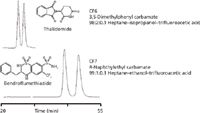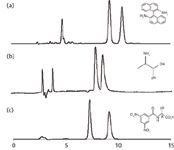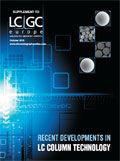Recent progress in chiral stationary phase development and current chiral applications
An update on some of the latest chiral stationary phases and their use in various separation modes.
Chiral separations remain a decided area of interest, as well as an all-too-often puzzle and on-going problem for many industries. High performance liquid chromatography (HPLC) remains the method of choice for most separations because of its robustness, transferability and instrument availability. Several chiral stationary phases continue to enjoy wide use in part because of their broad application. More recently, developed phases such as cyclofructans are finding increased use in HPLC and separation techniques. This brief review is an update on some of the latest chiral offerings.
Chiral separations in high performance liquid chromatography (HPLC) continue to be of great interest because of their prevalence in diverse areas such as the pharmaceutical industry, agrochemicals and food additives. Separation of enantiomers can be challenging because of their identical physical and chemical properties in an achiral environment. The advent of chiral stationary phases (CSPs) has been a boon to the field of enantioseparations. While research on specialized separation techniques using novel CSPs continues for the resolution of specific individual enantiomers, chiral separations on commercially available CSPs are a mature and widely used technique. Polysaccharide and macrocyclic glycopeptide CSPs remain the most widely used commercial chiral phases, with cyclodextrin-, cyclofructan-, π-complex- and protein-based CSPs also finding use. For non-HPLC separations, such as gas chromatography (GC) and capillary electrophoresis (CE), cyclodextrins dominate. The HPLC enantioseparation of larger molecules and multiple chiral centres has increased as the influence of biotech grows, and more polar molecules are of interest in discovery laboratories. Recently, the most important and widely used CSPs for HPLC were reviewed with sections on enantiorecognition mechanisms (1). There are plenty of resources and information available for one needing to perform chiral separations. Reviews have recently been published on general chiral HPLC methods for pharmaceutical analysis (2–4) and for supercritical fluid chromatography (SFC) separations of pharmaceuticals (5,6), including preparative-scale separations.
The State of Current CSPs
Chiral separation by HPLC continues to be the primary technique of choice, with many companies seeing an increase in the number of enantioseparations in their laboratories. The market continues to enjoy growth and maturation as older technologies are replaced by newer and improved technologies. A case in point is the expiration of the patent for the traditional coated Daicel columns (Daicel Corporation). Coated-type amylose and cellulose derivative CSPs are now offered by many companies and they remain one of the most important commercial CSPs. Daicel has started offering new bonded polysaccharide CSPs, which are advantageous for reversed-phase modes, mass spectrometry (MS) detection and preparative separations. A new class of commercial CSPs comprises the cyclofructan phases invented by Professor Daniel W. Armstrong (available through AZYP and Supelco/Sigma-Aldrich as the LARIHC and FRULIC columns). These phases are useful for the enantioseparation of primary amines.
Two apparent trends in the market are the increased use of SFC and smaller particles. The advantages of each are the reduced environmental impact and operating costs, as well as increased throughput. However, particles with diameters less than 3 μm are not commercially available, limiting microscale techniques. SFC has found more use particularly in preparative scale chiral separations, where the waste reduction and decreased solvent use is attractive to industry.
Polysaccharide CSPs
Chiral separations achieved by polysaccharide CSPs in HPLC account for approximately one-third of all HPLC chiral separations in the literature, and most of these separations are carried out on commercially available columns. The most commonly used phase on cellulose or amylose is 3,5-dimethylphenylcarbamate, which includes immobilized phases such as Chiralpak IA (Chiral Technologies), Chiralpak IB (Chiral Technologies), Lux Cellulose-1 (Phenomenex), and coated columns such as Chiralcel OD-H (Chiral Technologies), Kromasil-CelluCoat and AmyCoat (Eka Chemicals). Chloro-substituted polysaccharide CSPs have also found a lot of use, including tris(3,5-dichlorophenylcarbamate) such as the Chiralpak IC; tris(3-chloro-4-methylphenylcarbamate) like the Lux Cellulose-2; tris(5-chloro-2-methylphenylcarbamate) like the Chiralpak AY-H; and tris(3-chloro-4-methylphenyl carbamate) like the Chiralcel OZ-H. The selectivity of the Chiralpak IC column toward different enantiomeric compounds is demonstrated in Figure 1.

Figure 1: Normal-phase chiral separation of three compounds using a 250 mm à 4.6 mm, 5-μm Chiralpak IC column. Mobile phase: 70:30:0.1 (v/v/v) n-heaneâethyl acetateâdiethylamine. Adapted from http://immobilizedchiralcolumns.com/csp-robustness (courtesy of Chiral Technologies).
A reversed-phase study using tris chloro methylphenylcarbamate derivatives of cellulose and amylose concluded that using these CSPs in screening protocols have higher success rates in achieving baseline separations with shorter screening times (7). An updated generic separation strategy in normal-phase HPLC was reported using the commercial CSPs: Lux Cellulose-1, Lux Cellulose-2, Lux Amylose-2, Lux Cellulose-4, Chiralpak AD-H, Chiralcel OD-H and Chiralcel OJ-H (8). Reversed phase screening strategies for HPLC with Chiralpak IA, Chiralpak IB and Chiralpak IC with applications compatible with liquid chromatography–mass spectrometry (LC–MS) were also reported (9).
Cyclodextrin-Based CSPs
Although no new cyclodextrin-based CSPs have been brought to market since the last review in LCGC North America (10), the use of cyclodextrins still account for more than a fourth of all publications in chiral HPLC in recent years. The bonded cyclodextrin-based CSPs are used because of their robustness, wide selectivity and ability to enantioseparate in the reversed and polar organic phases. The mechanical stability of the cyclodextrin CSPs lends itself to wide use for preparative scale as well.
Macrocyclic Glycoprotein CSPs
The macrocyclic glycoprotein CSPs continue to fill a wide and useful niche in chiral HPLC because of their unique versatility and broad selectivity. These CSPs are unsurpassed in the enantioseparation of chiral amino acids. Supelco/Sigma-Aldrich offers a Chirobiotic method development kit containing V2, T, R and TAG columns for screening in polar ionic, polar organic, reversed-phase and normal-phase modes. A review of macrocyclic glycopeptide-based CSPs in HPLC methods for amino acid enantiomers and related analogs was published in 2010 (11).
Cyclofructan CSPs
The recently released cyclofructan-based LARIHC CSPs from AZYP, also available from Supelco/Sigma-Aldrich, show great promise in chiral HPLC separations. These columns include LARIHC CF6-P, which is considered the "king column" for separation of racemic primary amines; LARIHC CF6-RN, which separates nonprimary amines; and LARIHC CF7-DMP, which is the only commercialized cyclofructan 7 column and shows complementary enantioselectivity compared to the CF6-RN CSP.

Figure 2: Examples of separations of pharmaceutical enantiomers on CF6 and CF7 CSPs. Top: LARIHC CF6 column; bottom: LARIHC CF7 column. Adapted from http://www.sigmaaldrich.com/etc/medialib/docs/Supelco/Posters/1/daw-chiral-010711.Par.0001.File.tmp/daw-chiral-010711.pdf (courtesy of Supelco/Sigma-Aldrich).
LARIHC CF-6P is the only column that separates primary amines in a nonaqueous solvent using the polar organic mode. All LARIHC CSPs reportedly work well in SFC because of their use in both the normal-phase and polar organic phase modes. In a bit of marketing wordplay, LARIHC is "chiral" spelled backwards.

Figure 3: Chromatograms showing chiral separations in (a) normal-phase, (b) polar organic phase and (c) reversed-phase modes on LARIHC CF6-RN CSP. Adapted from http://www.sigmaaldrich.com/etc/medialib/docs/Supelco/Posters/1/daw-chiral-010711.Par.0001.File.tmp/daw-chiral-010711.pdf (courtesy of Supelco/Sigma-Aldrich).
Chiral Separations Today
Although the chiral market is maturing and stable, perhaps the biggest need in the field is an increased understanding of overall chiral methodologies and more practical training. As information is largely supplied by vendors to newcomers to chiral HPLC, novices can sometimes stumble around for a while wading through the vendor's literature and advice. In addition to an understandable sales objective, vendors occasionally misunderstand the customers' end-to-end chiral operation, so promised increases are sometimes not realized at the laboratory level. Furthermore, increased performance is also sometimes not realized because of low-tech reasons that may be related more to laboratory layout and operation, rather than the lack of latest technology and equipment. Newcomers should make use of the short courses on chiral HPLC that give a wealth of unbiased information to the participants and are offered at major conferences such as Eastern Analytical Symposium (EAS), Pittcon, Chirality and occasionally at American Chemical Society meetings.
Increased selectivity remains a challenge in chiral separations. With increased selectivity, loading can be increased in preparative chiral separations, which will provide the greatest cost savings. With significant cost savings in the separation process, companies can shift from using chiral selective synthesis for chiral purification to purification by chromatography. Although HPLC is used for preparative-scale separations, SFC continues to gain ground as the most cost-effective way to purify enough material for further studies.
The market is maturing, but technology has not moved forward in any remarkable way. Chiral HPLC still lacks (and probably always will) a CSP that can operate in all modes for enantioseparation of molecules from low to high polarity.
Acknowledgments
We gratefully thank Thomas Beesley of Chiral View LLC, Tracy Ascah of Sigma-Aldrich and Gary Yanik of PDR-Chemical LLC for their suggestions in the preparation of this manuscript.
Timothy J. Ward is a professor of chemistry and the associate dean of sciences at Millsaps College in Jackson, Mississippi, USA. He received his BS degree from the University of Florida and his PhD from Texas Tech University. Dr Ward served as chair of the International Symposium on Chirality in 2007. His research interests include chiral separations, the development of analytical LC and CE methods, and their application to pharmaceutical and archaeological analysis.
Karen D. Ward is an instructor at Millsaps College in Jackson, Mississippi, USA. She received her BS from Texas A&M University and her MS from Texas Tech University. Ms Ward has worked previously in the pharmaceutical industry at the Analytical Environmental Research Division at Syntex Pharmaceuticals in Palo Alto, California. Direct correspondence to: Timothy J. Ward at: wardtj@millsaps.edu.
References
(1) A. Cavazzini, L. Pasti, A. Massi, N. Marchetti and F. Dondi, Anal. Chim. Acta 706, 205–222 (2011).
(2) Y. Zhang, S. Yao, H. Zeng and H. Song, Cur. Pharma. Anal. 6, 114–130 (2010).
(3) E. Christodoulou, Cur. Org. Chem. 14, 2337–2347 (2010).
(4) Y. Hedeland and C. Pettersson, Chromatog. Sci. Ser. 101, 507–534 (2011).
(5) G. Webster and L. Kott, Sep. Sci. and Tech. 10, 251–282 (2011).
(6) G. Terfloth, Encycloped. of Chromatog. 1, 416–418 (2010).
(7) L. Peng, S. Jayapalan, B. Chankvetadze and T. Farkas, J. of Chroma. A 1217, 6942–6955 (2010).
(8) A.A. Younes, D. Mangelings and Y. Vander Heyden, J. of Pharma. and Biomed. Anal. 56, 521–537 (2011).
(9) T. Zhang, D. Nguyen and P. Franco, J. of Chromatog. A 1217, 1048–1055 (2010).
(10) T.E. Beesley, LCGC N. America 28(S4), 32–37 (2010).
(11) I. Ilisz, Z. Pataj and A. Peter, in Macrocyclic Chem., D.W. Fitzpatrick and H.J. Ulrich, Eds. (Nova Publishers, 2010), pp. 129–157.

Characterizing Plant Polysaccharides Using Size-Exclusion Chromatography
April 4th 2025With green chemistry becoming more standardized, Leena Pitkänen of Aalto University analyzed how useful size-exclusion chromatography (SEC) and asymmetric flow field-flow fractionation (AF4) could be in characterizing plant polysaccharides.
Investigating the Protective Effects of Frankincense Oil on Wound Healing with GC–MS
April 2nd 2025Frankincense essential oil is known for its anti-inflammatory, antioxidant, and therapeutic properties. A recent study investigated the protective effects of the oil in an excision wound model in rats, focusing on oxidative stress reduction, inflammatory cytokine modulation, and caspase-3 regulation; chemical composition of the oil was analyzed using gas chromatography–mass spectrometry (GC–MS).









